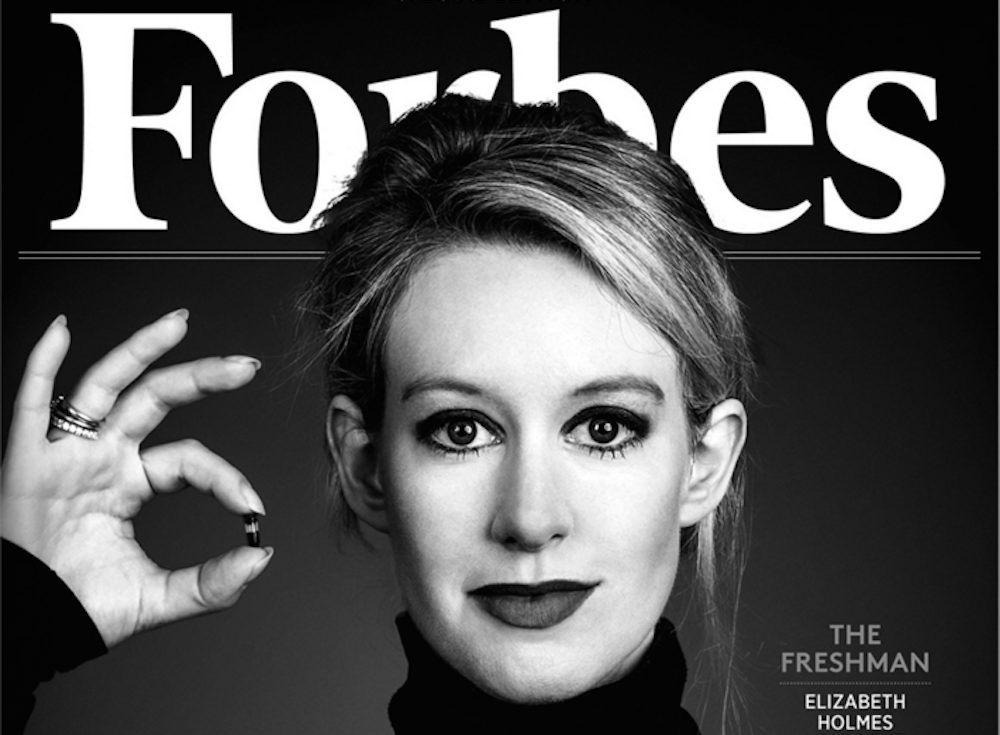
Elizabeth Holmes, the founder of the controversial blood-testing company Theranos, used to look good—physically beautiful even—in published photographs: On the cover of the June 2014 issue of Fortune, Holmes was shot in full color at a partial side angle revealing her contoured cheeks. Her hair is blonde and her blue eyes are huge and doe-like; she is the perfect white tech woman. The accompanying article compares her to Steve Jobs.
 But since October 2015, when the Wall Street Journal first showed that her company’s technology might not work and federal authorities began investigating Theranos, Holmes has looked perfectly beastly in the images illustrating savage media profiles.
But since October 2015, when the Wall Street Journal first showed that her company’s technology might not work and federal authorities began investigating Theranos, Holmes has looked perfectly beastly in the images illustrating savage media profiles.
In my analysis of Holmes’ declining pulchritude in the media, I find myself engaged in a squirm-inducing labor that picks apart another woman’s appearance. In her excellent book The Argonauts, memoirist and critic Maggie Nelson warns us that even while we challenge the social categories that oppress us, we may simply wind up reinforcing those oppressions; that even while we think that we are wielding crowbars that will let us out of our social and political prisons, we actually just hold keys that open into other kinds of jails. I am going to proceed, nevertheless, because Holmes’ photographic debasement is interesting, wrong, and diverts us from real issues. Even if I am looking out of my sanitarium window, I like the view.
According to my studies, Elizabeth Holmes suffers the tragedy shared by most humans over the age of 12: She must be very carefully posed in order to look pretty in photographs. Photographers have a 367 percent chance of making Elizabeth Holmes look supremely attractive if they shoot her straight on or at a slight angle. She should be shot smiling, but only slightly, and with a closed mouth. Black and white portraits, which make people appear more glamorous and younger, are preferable to color. Holmes must be heavily contoured and shot from way on high and straight on, so her cheekbones will appear. If she is not shot from a good angle, or is lit badly, or has teeth, or is in color that is not retouched, she will look ungainly, maybe slightly pudgy, jowly, or even frightened or insane.
Elizabeth Holmes started Theranos in 2003, when she was a 19-year-old Stanford University chemical engineering major. She had the idea that a wide variety of medical tests, for everything from Herpes to cholesterol, could be accomplished using an infinitesimal amount of blood and what she calls an “Edison machine.” She sold this idea to Walgreens, which began building Theranos Wellness Centers. This new model for blood tests would liberate the consumer from having to go through a physician to get a blood test approved.
Many people loved the idea. Henry Kissinger thought Holmes was onto something. George P. Shultz concurred. Oracle’s Larry Ellison glommed onto her. So did former U.S. Secretary of Defense William J. Perry and former U.S. Senator Sam Nunn. So many formerly incredible men who were not life scientists thought that Elizabeth Holmes was smart that they dog-piled onto her board of directors and gave her money. In 2005, Theranos was worth $16 million, and then in 2010, it was worth $1 billion.
Everybody loved Theranos, except for intelligent people in Silicon Valley who just murmured warily and didn’t invest. In September 2015, Holmes was still on her upswing, and Forbes shot her in black and white, with her hair up, for its “400” issue ranking the richest people in America. She looks matte and resplendent with heavy lipstick on her Mona Lisa smile and a lot of mascara. She’s contoured so that she has deep cheekbones, and she’s also wearing the black turtleneck favored by Steve Jobs.
In October 2015, her troubles began: The Wall Street Journal published its first denunciation of Holmes, “Hot Start-Up Theranos Has Struggled With Its Blood-Test Technology.” Here, reporter John Carreyrou noted that Theranos was now valued at $9 billion, but that an insider admitted that some employees were “leery about the [Edison] machine’s accuracy.” Also, according to an insider, the company had only done a paltry 15 tests using the Edison in December of 2014. But the flow of attractive Holmes covers kept multiplying on newsstands. The same month that the Journal drew its first Theranos blood, Holmes appeared on the cover of Inc. wearing the black turtleneck, smiling with Mona Lisa flair, alongside the banner, “The Next Steve Jobs.” She is shot straight on but is not short-lit, though she is contoured and wearing lipstick. That same month, Holmes appeared on a cover of T, The New York Times Style Magazine. Her three-quarters profile shot might have been ungorgeous except that her hair, which is tied back, has tendrils that sweep elegantly over the lower part of her face. Holmes is sort of squinting adventurously and appears to be standing in the Wonder Woman position, which Harvard Business School Professor Amy Cuddy has famously said can improve your confidence.
But evidence piled up in outlets including the Wall Street Journal, Scientific American, and the Journal of Clinical Investigation that Theranos testing is prone to false positives (though, blood testing technology in general seems teeth-gratingly inaccurate if you look too deeply at the statistics).
Now the knives were out, and other media gleefully began using the worst Holmes photos they could find. Business Insider illustrated one article with two images: One showed her naturally lit, wearing a turtleneck, not-smiling, scared-looking, shiny, uncontoured, and looking down in a manner that maximizes the jowls. This picture could be justified as an action shot; it’s a still frame from a disastrous interview the article dissects, where Holmes began to see her future and bright dreams slip away. However, the other image has no apparent utility except to illustrate that Holmes is not attractive or prepossessing, even when she tries to be. In this picture, she stands in a black formal gown with her hair down, but she’s stooped and tensely smiling as if she is apologizing.
This spring, the unflattering photos continued to proliferate in both the Wall Street Journal and Vanity Fair.
But the worst photographs came after federal authorities confirmed in March that they are investigating Theranos and Holmes for misleading investors and federal officials. New York magazine ornamented its April 2016 article on the criminal probe with a low-angled, top-lit shot of Holmes looking crazy-eyed and open-mouthed and as if she is just about to start laughing hysterically or maybe begin screaming. When you click on the magnify button helpfully placed on the photograph, you can see very clearly that Holmes is wearing heavy foundation, has moles on her cheeks and bags beneath her eyes, and is drained of all human color.
We have seen this story-told-in-pictures before, but usually it is in fairy tales involving the demonic daughters of Salem, who begin apple-cheeked and smiling but then turn froggy and old as soon as the baby-eating allegations get out. It may be true that Holmes is a masterful con artist who swindled a host of investors. But what’s more fascinating is the art of the photographer and editor who play an equally clever game by staging this circus of hate.
At first, they depict Holmes as a paragon of white female exceptionalism, a myth she doesn’t necessarily live up to. Then, she is deeply deprived of that form of affirmative action when she is revealed as more human, and portrayed as unrealistically hideous. The public appetite for beautiful white female billionaires is ravenous for about two minutes, after which it devolves quickly into a blood tide of anti-feminist jealousy and lulz. It is unclear how to divvy up Holmes’s assigned guilt: A look at the Dorian Gray-like fable told in the nation’s magazines and newspaper teach us that while we may harbor reasonable anger against Holmes for her possible negligence or deceit, we reserve the rest of our ire for her sliding cheeks and bug eyes, which I predict will get ever sweatier and more dewlap-focused as her dog days drag on.




Send A Letter To the Editors